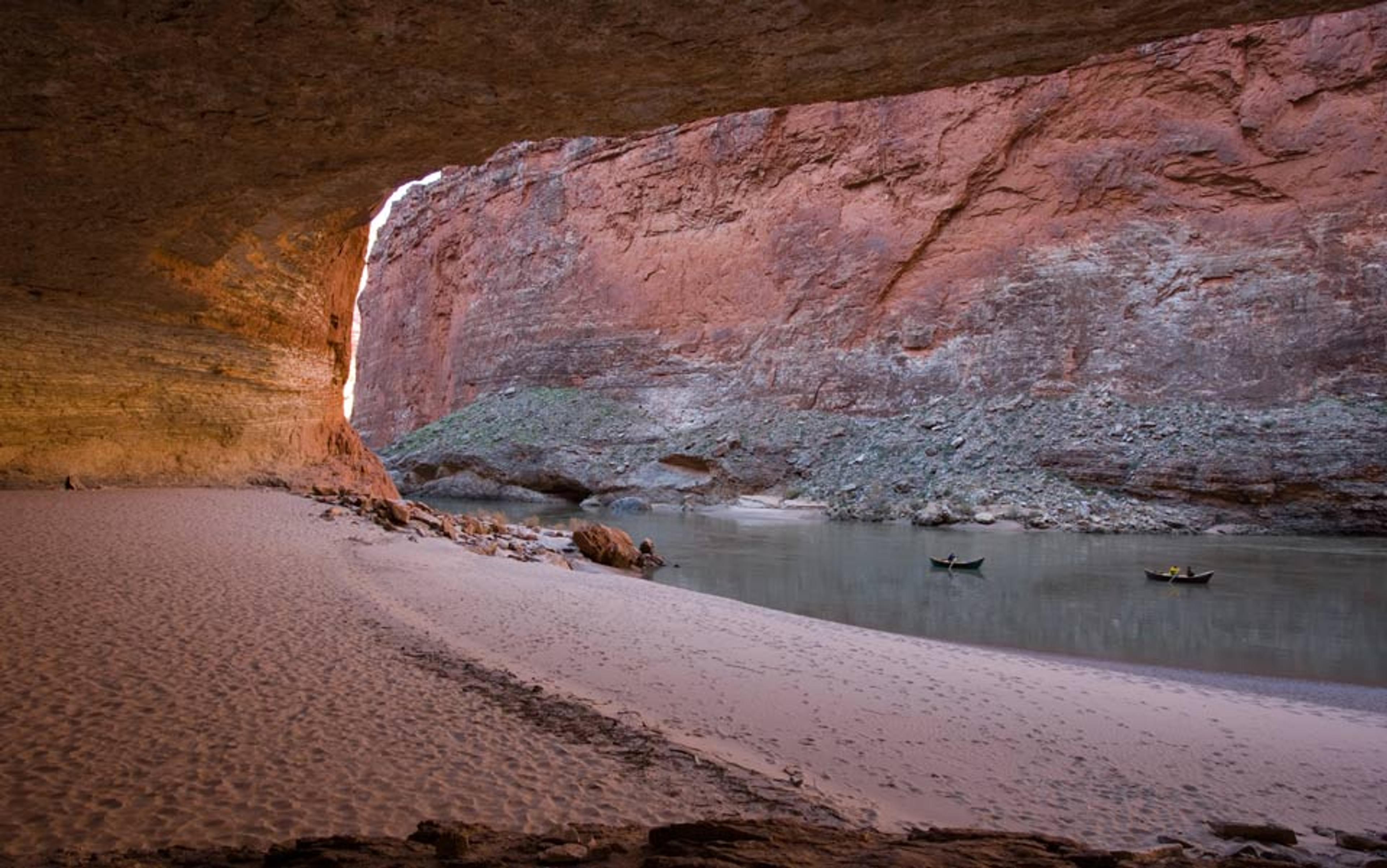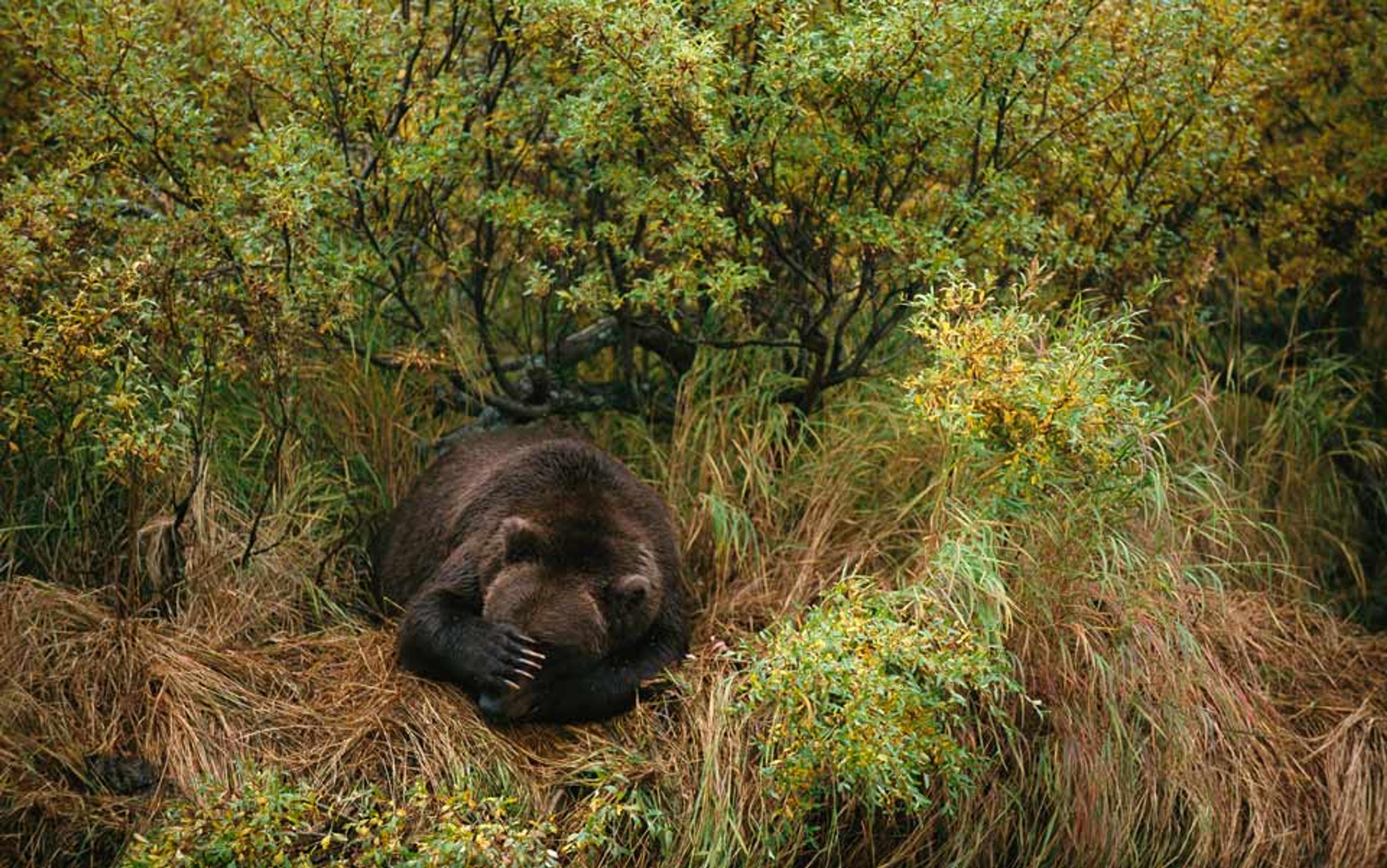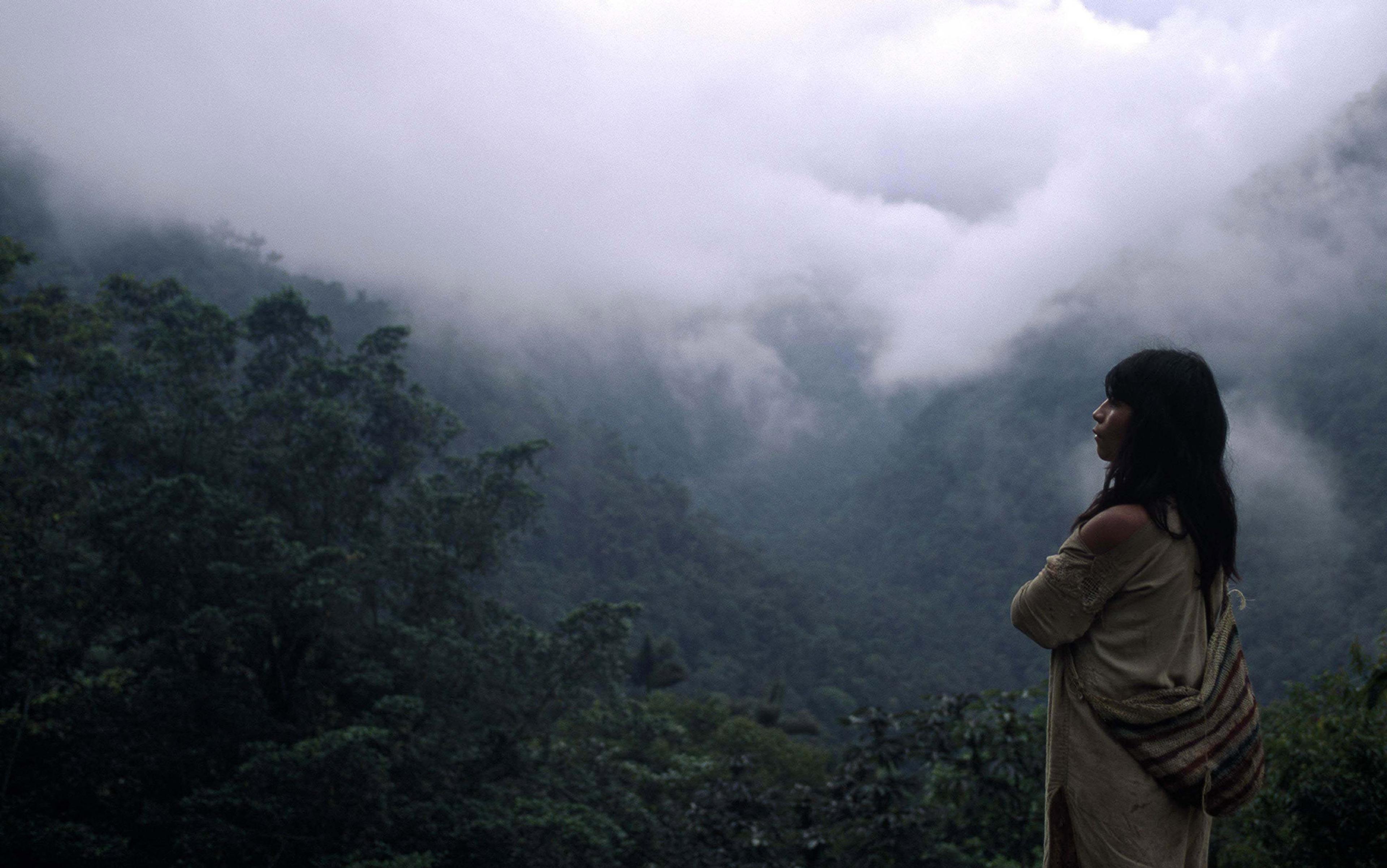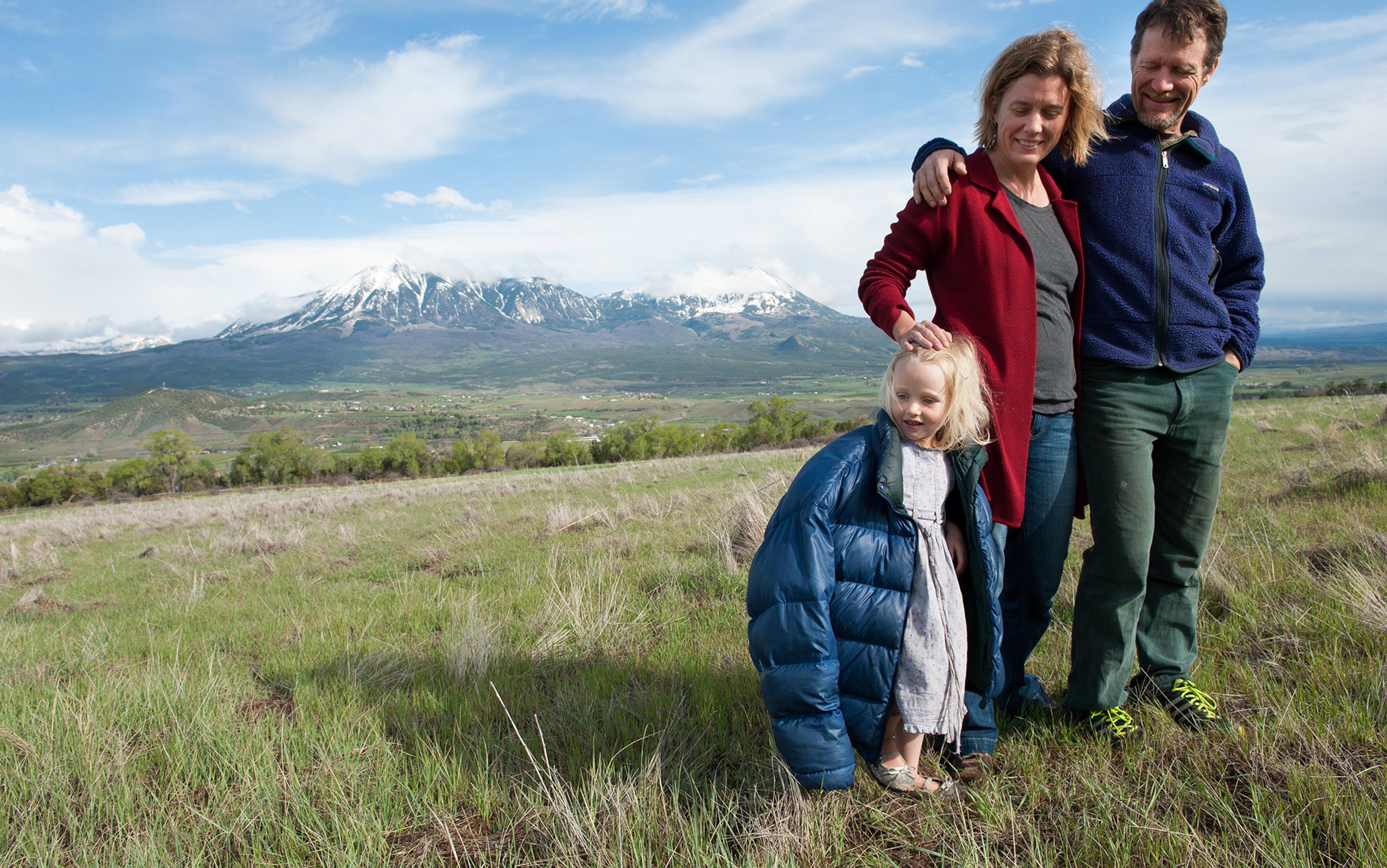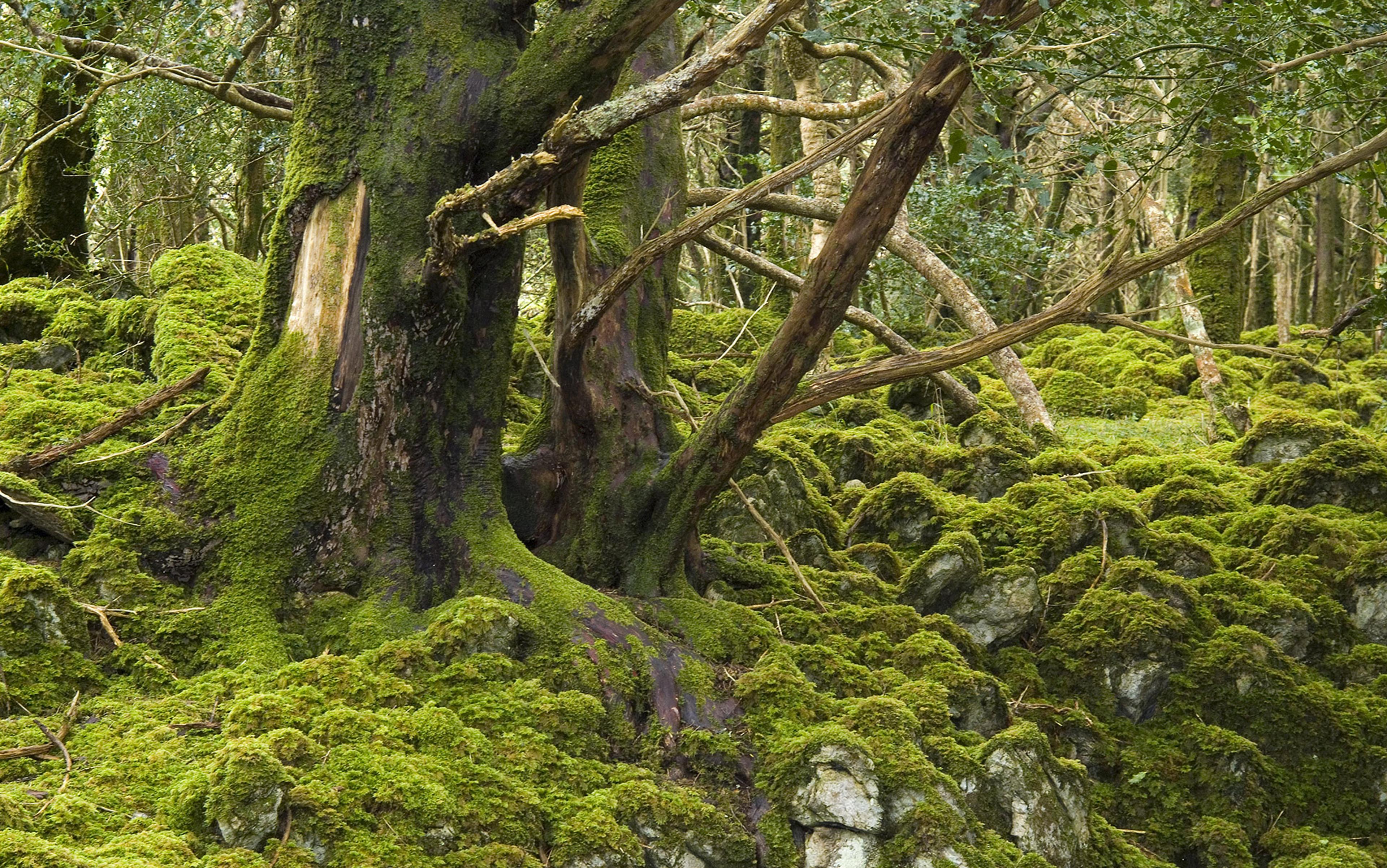With a couple weeks of rowing in front of me, I turned the bow of the whitewater raft to the left and pulled hard at the oars, backing away from the monster waves between me and the sandstone cliffs on the Colorado River’s left bank. A wave broke over the boat. Another one caught me in the face. My boat partner, Ben, held on to avoid being swept off. I was finally floating the Grand Canyon, something I’d always wanted to do. Life was reduced to its natural, pre-civilised state. Everything I normally did – working, going to the store, paying bills, texting, phone calls – did not need to be done. What I did need to do was devote my total attention to not flipping our raft.
Civilisation seems to require from us an almost constant state of divided attention. On the river, my mind cleared. Food tasted particularly good. Reading by flashlight before sleep was exquisite. Each sentence in my book seemed so good, leaping out in utter clarity. Heavy rains back in January had triggered an unusually great show of native wildflowers that spring. Prickly pear cactus was covered with showy pink blooms, and claret-cup cactus with flowers the colour of arterial blood. Pastel orange globemallow and white evening primrose twined over the rocks and sand. Clumps of cardinal monkeyflowers shone like vermilion beacons around seeps and springs in the shade of side-canyons.
But it was the canyon walls themselves that made the deepest impression. Drifting between rapids, I gazed up at the top of the cliffs surmounted by even higher escarpments: a vertical mile of rock, fossils and various forms of life comprising 1.7 billion years of Earth’s history. In the Grand Canyon, the Colorado River slopes toward the sea at an average of eight feet per mile, so as we floated downstream, the rocks at river level got older. Five miles downriver from where we launched our boats, the river runs through 280-million-year old shale out of which a geologist chipped a fossil dragonfly with an eight-inch wingspan. Thirty-two miles further on, the river cuts into limestone formed just before the Devonian extinction 374 million years ago – when more than half of all marine genera and the first vertebrates to crawl out of the water, onto land, were wiped out. By mile 58, the river gets down to 545-million-year-old sandstone containing fossils of extinct marine life forms called trilobites.
The great work of erosion that exposed these lapidary antiquities is far more recent—perhaps only 5-6 million years old, say some geologists. In its excavations, the waters of the Colorado River and its tributaries insinuated themselves into and enlarged upon any weakness, fault, and crack in the rock. The Grand Canyon is full of overhangs, hollows and caves. Hundreds of millions of years after trilobites and giant dragonflies were gone from the Earth, later forms of life exploited these shelters. Explorers found one cave in the Grand Canyon containing round, grassy dung from shaggy-haired, ice age ground sloths that became extinct some 10,000 years ago. Over nine millennia after the sloths disappeared, Pueblo Indians built stone dwellings in hollows and overhangs in the canyon walls.
In such a setting, wrapped in a deep silence broken only by the sound of the river, the progress of evolution from trilobites to human beings seemed so slow and stately as to appear motionless, in human terms. What I didn’t see at the outset of my trip was that evolution had been picking up its pace. Even as I rowed down the river, one of evolution’s most characteristic present drivers – the rapid relocation of organisms from one place to another by human beings – was transforming the desert around me and was about to nearly kill one of my fellow boaters.
It was April 2008. A friend of a friend, a 30-something tech engineer from southern California – I’ll call him Jason, but that’s not his real name – had been awarded a coveted permit to make the three-week, 226-mile-float through the Grand Canyon in the Park Service’s annual lottery. However, Jason had never mounted an expedition of this complexity, so he asked my friend Stan to lead. Stan, a veteran of dozens of Grand Canyon trips, wanted to go, but didn’t want the hassle of organising, so he asked his girlfriend, Kathy. Kathy was an Idaho rancher in her fifties, a strong and skilful outdoorswoman with previous Grand Canyon experience and a touch of savoir-faire. She often showed up for dinner in camp wearing lipstick and earrings. She was relaxed and friendly. Everyone liked her.
From there, the expedition filled out with friends, and friends of friends, 15 of us on seven rafts from four western states. There was one of Jason’s young microchip engineer friends and a Silicon Valley millionaire who’d cashed in his stock options. Our group also included the sales manager for a whitewater raft manufacturer, a real-estate developer, a reproductive health counsellor, a student, a blue-ribbon vegetarian chef, two construction workers, and a professional helicopter pilot.
The pilot – I’ll call him Rob – was a stocky, affable man with a ready grin under a Fu Manchu moustache who’d spent the previous several months fighting forest fires in the mountains of Mexico for a US company on contract with the Mexican government. A day and a half before the start of our trip, he’d left the remote village where he’d been working and driven to Mexico City. From there, he took a commercial flight to Las Vegas, rented a car, and drove all night to the Grand Canyon. I liked him immediately, probably in part because I’d worked on helicopters as a rescue medic and firefighter during my two decades as a park ranger. Those of us who rode in back regarded those who flew us safely in and out of various dodgy situations with an admiration verging on that of rock-and-roll groupies.
Having initially avoided the rapid’s most violent hydraulics, I collided with a rock and found myself running the rapid backward. I turned the boat back around in time to enter a sculpture garden of boulders. I zigzagged through them, and then things quietened down. Ben and I took off our helmets, grinned at each other, and high-fived.
For the rest of the day we took turns at the oars, and late in the afternoon we tied up our boat next to the others to make camp at what had once been a long, sandy beach and was now a jungle of tamarisk.
Tamarisks can grow a root more than 30 feet deep, draw salts out of the ground, and excrete them in leaf litter, poisoning the soil for other plants
Tamarisk, or salt-cedar, is the common name for several species of small trees native to Eurasia and Africa that form tangles of scratchy, arching limbs tipped with feathery, needlelike vegetation. Introduced to the US in the 19th century, tamarisks were planted in the Southwest as ornamentals, for windbreaks, and to stabilise riverbanks. By the mid-20th century, tamarisk was spreading everywhere. It proved a copious producer of seed with a voracious thirst for scarce desert water. Tamarisks have been known to grow a tap root more than 30 feet deep, draw salts out of the ground, and excrete them in leaf litter, poisoning the soil surface for other plants. They out-compete natives such as cottonwood and willow, and today form the dominant woody species along rivers in the American Southwest.
We carried our gear into the hollows that previous boaters had broken into this thicket and set up camp, cooked dinner and cleaned up. We seemed to work effortlessly, harmoniously, with no direction from Kathy. We slept deeply that night, from the exercise and to the sounds of the river. The next day, we made our way downriver to a camp at Hotauta Creek, and the night after that, to the mouth of Blacktail Canyon, a slot in the main canyon wall so narrow you could touch both sides at once. In the evening we strolled up the warm, sandy bottom, peering up at the curved sandstone lit orange by the indirect glow of the last rays of the sun. I don’t remember seeing Rob up there that night.
High clouds streaked the sky the next morning, and a persistent chill hung over the river. I was absorbed in the scramble to eat breakfast, finish camp chores, and pack up my gear when Kathy walked over with a worried expression. She said Rob had been unable to get out of bed that morning. He was having a hard time breathing and he’d briefly lost consciousness a few minutes before. She asked me to have a look at him.
Looking down the beach, I saw Rob in his sleeping bag, surrounded by three worried members of our party. I told Kathy that all my emergency medical care certifications were expired, because I no longer worked as a ranger. She replied that, nevertheless, I was still the most medically qualified member of the party and repeated her request. I asked her to get our medical kit and meet me at Rob’s bedside.
When I reached him, Rob was dazed, pale, coughing and gasping for air. I asked a few questions and recorded in my notebook that he was 43, 5ft 9in (175cm), 215lb (97.5kg), and had an underlying condition of mild asthma, well-controlled by infrequent use of an albuterol inhaler. He’d used the inhaler that morning when he couldn’t get enough air, but when he’d held his breath to get the medicine into his bloodstream, as his doctor taught him, he’d passed out. His pulse was rapid, and his blood pressure higher than I would have liked. He had a fever of just over 100 degrees Fahrenheit (37.7 Celsius).
Rob had been working out of remote, rural towns in Mexico, eating local food, in contact with farmers and their cattle, pigs and fowl. Around the time he left Mexico, he’d had a bout of diarrhoea. On the first day on the river, he’d had sniffles and a mild cough. By the second day, he felt chilled in the bright sun. That evening he’d run a fever and coughed all night. He’d slept away from others so as not to disturb them as it got worse.
That morning, when his fellow boaters found out he was sick, they’d contributed and he’d swallowed a witches’ brew of non-prescription cold remedies, herbal medicines, and one prescription medication, so far unidentified. A medic’s job is to find out what drugs are ‘on board’ before sending a patient to the hospital. I asked Kathy to find Peter, the tall Oregon real-estate developer and expert boatman who’d given Rob the prescription pills, and bring me back Peter’s medicine bottle. But Peter was refusing to produce the container for fear that he might later be sued.
‘This guy is not going to be a whitewater rafter today. We need to fly him out of here as soon as possible’
I’d spent two decades training in, dispensing, and teaching emergency medical care, but I was no doctor, and our first aid kit was no hospital.
‘Kathy,’ I said, standing up from where I’d been kneeling beside Rob’s sleeping bag in the sand. ‘This guy is not going to be a whitewater rafter today. We need to fly him out of here as soon as possible.’
Kathy nodded thoughtfully and went off to consult with others. I got back to work, inflating the blood pressure cuff, listening to Rob’s breathing through my stethoscope, and palpating the lymph nodes around his chin and neck.
Kathy returned.
‘We don’t want to overreact,’ she said. ‘Rob may just have a bad flu. If we call for a helo and the Park Service determines we were rash about it, Jason will lose his right to future permits. Let’s get on the river. We’re camping tonight at Stone Creek. There’s a landing zone there. If Rob’s worse, we can send him out then. Why don’t you go with Rob on Bryan’s raft, and keep him from falling off into the water.’
I scrambled to throw my stuff in drybags, and was the last one down to the boats. I helped Rob aboard Bryan’s raft. He lay across one of the thwarts, forcing a smile. I shoved off and Bryan leant into his oars. It was 10:15am.
At 10:45 Rob was complaining between gasps that he couldn’t get enough air. At 11am, Stan rowed the boat he and Kathy shared over for a conference. Despite the worsening emergency, Kathy was sticking to the plan.
We continued downriver into the next rapid, and then another. Rob shivered violently as the icy waves broke over him. To get out of the splash, he crawled behind Bryan onto a pile of equipment lashed down with tarpaulin, where he lay spread-eagled, eyes closed, clinging to the straps. I climbed over to hold onto his life jacket so he wouldn’t be swept off the boat. A bad swim and a gulp or two of water down the wrong way could finish him, I judged.
At 1:30pm we stopped for lunch. I took vitals again. Rob’s fever was now 103°F (39.4°C), his pulse 112 per minute, his breathing rapid and shallow, and his blood pressure even more elevated.
‘TIME TO MEDEVAC HIM!’ I wrote in my notes.
I conferred again with Kathy, but she seemed focused on getting to Stone Creek, which, she reminded me again, was a well-known spot to land a helicopter. We got back on the water. We were moving toward the Grand Canyon’s Inner Gorge where the walls drew close, towering, nearly vertically, more than two thousand feet from the river. The river had now cut downward into the 1.7-billion-year-old Vishnu Schist, the oldest rock in the Grand Canyon. Shiny, inky black, and tortured into strange hollows and curves, it glinted malevolently along either bank.
Before the canyon narrowed, there had been a fair number of places safe enough for a helicopter to enter and land. Now they were few and far between. The party descended into bickering. I was angry with Peter for withholding the name of the prescription drug, and at Kathy for what I thought was a ludicrous assignment to keep a man who had no business being on a boat from falling off it. Still, I knew that loss of orderly decision-making had in itself been fatal for some wilderness groups. In 1869, the first party to explore the Grand Canyon splintered into two, and three members who separated and tried to hike out never made it. We had to stay together and work our way through this.
We tumbled down Bedrock and Dubendorf rapids, running hard for Stone Creek. When we got there, we tied our boats to a dense stand of willows along the right bank. I helped Rob out of the boat, walked him to the shade of a bush and took vitals again. His fever was now 103.5°F (39.7°C), he was pale, panting and, in my estimation, not oxygenated enough. I went down into the willows to give Kathy my latest assessment.
I concluded my recitation by saying emphatically: ‘So let’s medevac him, now!’
There was a crackling in the willows to my right. I turned to see Jason charging toward me, having apparently come upon us just as I delivered that line.
‘Hey!’ he yelled. ‘We’re on my permit, and no one is getting medevaced until we have a group meeting!’
‘Keep that guy away from me so I don’t punch him. And please get the satellite phone’
I didn’t reply, but I put my arm around Kathy’s shoulders and pulled her away. ‘Can we talk privately?’ I asked her as I led the way through the brush.
Once we were out of earshot, I faced her. ‘Keep that guy away from me so I don’t punch him,’ I said. ‘And please get the satellite phone.’
‘OK,’ she said, and walked away toward the boats.
When Kathy returned, we opened the waterproof case, flipped up the little antenna, and pushed the power button. The digital display said the phone was seeking a satellite. Then it said that some more, and then it kept saying that. Kathy paced upstream and down, pointing the phone at the now narrow strip of sky between the great edifices of stone. It was no good.
I went back to check on Rob. Kathy kept trying the phone. I had been in situations before in the wilderness where things got bad, and then they got worse. This was starting to look like one of them.
And then our luck changed. In the Grand Canyon, some concessions companies run tourists up and down the river on huge inflatables with motors so powerful they can drive upstream through the rapids. For people who spend weeks to get there by oars, being passed by one of these monsters loaded with gaping tourists is irritating in the extreme. I’ve always hated them. Now, when we heard the roar of a big motor and this gargantuan, pale-blue barge came around the bend, I adored it.
We ran out to the water’s edge, waving and yelling. The boat operator throttled back and pulled up to the bank. We asked if he had a satellite phone. He said yes. His deckhand dug it out. We turned it on. It hit a satellite almost immediately. We later found out that the company we’d rented ours from had lost one or more of its satellites.
I called Park Dispatch and transmitted my report. Within a half-hour, a deep rumble echoed off the cliffs downstream, and I saw the park’s helicopter orbiting downward, rotor clattering. It landed and a paramedic in an orange jumpsuit and a white jet helmet deplaned and met me. I transferred my notes and information, she loaded Rob and put him on oxygen, and the helicopter took off.
Rob was semi-conscious with a fever approaching 104°F when he landed in Flagstaff, Arizona. He spent two days in hospital on antibiotics and respiratory therapy. One of his doctors told him that, had we waited another hour or two to send him in, Rob might not have made it.
The next morning the parallel dents of the helicopter’s skids were still visible on the wind-rippled beach. Sunlight crept downward across a majestic face of red limestone hundreds of feet above our camp.
It was beautiful.
‘No one cares,’ I wrote in my notes.
Overnight, half of our party had come down with what Rob had brought from rural Mexico: terrible, hacking coughs, fever, and profound weakness; a viral pneumonia. Kathy called a rest day, and we all lay around camp, trying to weather the storm. The only useful thing we did that day was refill our water jugs from Stone Creek.
sweats alternately soaked our sleeping bags and left us shivering with chills. I could hear coughing all over camp
On April 8, we set out in our boats again. Feverish and too weak to row or even sit upright, I spent the day as Rob had, clinging spread-eagled on a pile of gear in the back of Bryan’s boat, periodically douched and shivering in the cold waves. When we stopped for lunch, I crawled under the shade of a bush and tried to sleep, but couldn’t.
Our fevers eventually broke during the day but persisted at night, accompanied by sweats that alternately soaked our sleeping bags and left us shivering with chills. Those of us who were sick weren’t getting much sleep. I could hear coughing all over camp.
The one who took it most stoically was Peter. He was obviously very ill, but never complained. When his fever spiked, Kathy called another rest day. Peter had set up his tent away from all shade, and he spent the day in it. It must have been well over 100°F inside, because it was in the 90s outside on the beach. I heard Peter coughing and gasping. It was hard to take, watching a man nearly kill himself by sweating out a virus. Through the tent wall, I asked if he wanted me to bring him water or anything else. He gruffly declined.
‘Keep this great wonder of nature as it now is,’ President Theodore Roosevelt told a crowd looking out over the Grand Canyon in 1903. ‘You cannot improve on it. The ages have been at work on it, and man can only mar it.’ In 1908, Roosevelt protected the Grand Canyon as a national monument. But keeping the Grand Canyon as it was has proved more difficult than it sounded at the time.
In the early 20th century, hunters and trappers who were employed in a federal programme to make the West safe for cattle and sheep forced wolves to extinction in the Southwest. In response, by 1924 on the north side of the Grand Canyon, deer herds had expanded far past the land’s capacity to support them, adding to the overgrazing by domestic cattle, sheep and escaped donkeys gone wild. Eurasian plants such as tamarisk and cheatgrass showed up.
A dam was completed on the Colorado River upstream of the park in 1963. Water released downstream came from deep in the resulting reservoir, where it was unnaturally cold year-round, thus favouring non-native fish. Since then, three native fish have become extinct, and others are endangered. With the river’s flow controlled, seasonal floods no longer kept the Grand Canyon’s beaches free of the kind of thickets tamarisk is so good at forming. According to the park’s botanist, of the roughly 1,750 species of vascular plants in the Grand Canyon, 201 are exotic. Exotics are found in every plant community there. Of the natives, nine are found only in the park.
Evolution makes chain reactions. When the ground sloths that left their dung in the Grand Canyon’s Rampart Cave became extinct, the big, candelabra-shaped yucca plants known as Joshua trees, which grew over large portions of the Southwest, lost their best friends. Sloths liked to eat the tree’s fruit, and distributed the seeds in their dung. When the ice age receded and the planet warmed, Joshua trees might have been winners had they been able to expand their range more quickly. But without the sloth and other large Pleistocene mammals to carry their seeds, they could migrate no more than six feet a year. Joshua trees now occur in a fraction of their former range, and climate change is expected to reduce it further still.
exotics that take hold often have an evolutionary advantage: in their new home, they have no natural predators
Species with very small ranges, such as today’s Joshua trees and the nine plant species that occur only in the Grand Canyon, are poised to be evolutionary losers. They are too vulnerable to misfortune in that one small area – a wildfire, a change in moisture or other growing conditions, an attack by animal, competing plant, insect or disease. On the other hand, invaders such as tamarisk that exploit humankind’s tendency to move things around are evolution’s present winners. If you expand your range to include multiple continents, you are the Google of the plant world.
Not every species relocated from one continent to another becomes invasive, or even survives. Quebec is in no immediate danger of being taken over by the tropical orchids that someone keeps in her greenhouse there. However, exotics that do take hold often share an evolutionary advantage over native competitors: in their new home, they have no natural pests or predators.
In 2001, after extensive testing, biologists from the US Department of the Interior set out to even that score by importing and releasing a tamarisk leaf beetle native to China into the American Southwest. By 2009, the beetle had found its way to the Grand Canyon. Park Service biologists have now seen the first cases of tamarisk dying from beetle infestation. No one suggests that the beetle will eliminate tamarisk; the two coexisted happily in Asia before their North American debut. But biologists hope that the beetle will eliminate tamarisk’s previous unfair advantage.
A year after our trip, a novel strain of viral pneumonia also crossed borders, emerging from Mexico to become a transnational epidemic. In March 2009, more than 1,000 people showed up at clinics and hospitals in several Mexican states with the high fever, profound weakness and respiratory distress we had suffered the previous year on our Grand Canyon trip. In the first two months, 84 people died. Once isolated, the infectious agent proved to be a representative of a group of viruses known as H1N1, or ‘swine’ influenzas, so-named because they infect domestic pigs and can pass from them to people. It was a strain of H1N1 that killed 40-50 million people in the world pandemic of 1918.
During the following month, April 2009, the H1N1 identified in Mexico turned up in two boys in southern California. From there, it infected some 43-88 million Americans, killing as many as 18,000 within the first year. Canada suffered 45,771 cases between swine flu’s arrival there and 2010, 505 of them fatal, and the United Kingdom saw 474 fatal cases in the first year alone. After the epidemic made a blood test available, Rob told me he had tested positive for H1N1 antibodies.
The ability to exploit new places to live in a world in which humans rapidly move things around is shared by tamarisk and swine flu. Swine flu also represents an older evolutionary strategy created by human domestication of animals, which began about 10,000 years ago. Swine flu is part of a lineage of diseases that exploited close contact between herds of domestic animals and people, including bubonic plague, brucellosis, tuberculosis and E. coli. Meanwhile, the invention of agriculture created an evolutionary opportunity for other plants that grew unbidden in nitrogen-rich fields, got bigger faster than crops, and dispersed copious seeds. Introduced to North America, these became the sorts of weeds the National Park Service finds most difficult to deal with in places such as the Grand Canyon.
For most all of my life, I have periodically gone into the wilderness in places such as the Grand Canyon to appreciate nature. And I’ve tried not to see – in the same way I might turn my head away from vomit on the sidewalk – that civilisation is part of evolution. To the extent that I have looked at civilisation’s effect on evolution, I’ve always seen it as subtractive, as the force driving Earth’s sixth major extinction. But in truth, as new organisms show up and adapt to their new homes, human-driven evolution is also additive. Something new is being created. It just isn’t what I wanted.
we created a global gladiator show in which anything from anywhere can try its hand at taking over a national park or a human body
Since our 2008 Grand Canyon trip, I still go to steep myself in the stillness of wild places, revel in the ancient rocks and the history of life on Earth. I don’t want the Park Service to stop its efforts to control tamarisk and other weeds in the Grand Canyon. If the rangers cannot perfectly reflect Roosevelt’s admonition to keep the Grand Canyon as it was, they should come as close as possible. However, now I’ve found it helps me not to turn away. You can see better with a more unblinking, level gaze.
In the 1960s, the geoscientist Paul Martin, who’d done research at Rampart Cave, hypothesised that when ground sloths and other large ice-age mammals disappeared between 10,000 and 12,000 years ago, it was because ancient human hunters went on a blitzkrieg of meat-eating. His theory has been widely criticised, but whether you believe it or not, human forces have clearly been part of evolution for millennia, ever since herding and agriculture created evolutionary opportunities for diseases that jump from animals to people and for some of the world’s most pernicious weeds. From the age of sail into the age of jet travel, we took our winners around and introduced them to the locals, creating a global gladiator show in which anything from anywhere can try its hand at taking over a national park or a human body.
In the end, after our trip, Rob didn’t hold Kathy’s decisions against her. Human-driven evolution dealt the cards and, even if we bickered over strategy, we played our hand well. No one died. But our struggle was limited: just a fortnight in the tamarisk, albeit with fevers, weakness and respiratory distress. The larger struggle by human civilisation to adapt to the rapid changes it has set in motion will be more dangerous. Let’s hope it comes out half as well.
This story is true, but the names, descriptions and origins of the people in it have been changed to protect their privacy.
